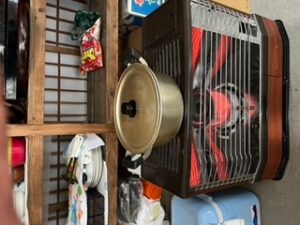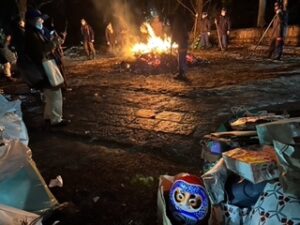Dontosai 2022
- At January 15, 2022
- By admin
- In Annes Letters
 0
0
Dear Family and Friends,
January 14 is Dontosai in Japan. That marks the final day of the New Year period. That means a day of special and significant events. Usually I head to the most boisterous Shinto Shrine’s Naked Festival. For that participants, clad in loin cloths, ring bells as they march through the city, heading to Osaki Hachiman Shrine. There they circle a raging bonfire, drink warming sake, and pray with hundreds of others at the huge, welcoming, and noisy altar.
But this year was different. First, because of Oni[1] Omicron sweeping through the country. Also, I felt unsure of the roads leading there. I have become very cautious since breaking my arm just over a year ago. As I learned firsthand, ice can hide in silent patches, causing long term disastrous consequences. But lucky for me, a friend invited me to her sister’s one day restaurant opening (usually closed in winter) near a well-known Shinto Shrine and Buddhist Temple.
I was thrilled by the chance. So, after my art lesson nearby, I head for a nourishing warm lunch. However, to my surprise, Kazue greeted me with open arms saying, “Hello Anne. How nice to see you! But why are you here now?” It turned out the restaurant would open at 4 pm, when many people would be heading to the Shrine to toss their New Year decorations into the sacred, cleansing bonfire. (People had been coming all day, but not as many as would be there at night.)
January 14 is Dontosai in Japan. That marks the final day of the New Year period. That means a day of special and significant events. Usually I head to the most boisterous Shinto Shrine’s Naked Festival. For that participants, clad in loin cloths, ring bells as they march through the city, heading to Osaki Hachiman Shrine. There they circle a raging bonfire, drink warming sake, and pray with hundreds of others at the huge, welcoming, and noisy altar.
But this year was different. First, because of Oni[1] Omicron sweeping through the country. Also, I felt unsure of the roads leading there. I have become very cautious since breaking my arm just over a year ago. As I learned firsthand, ice can hide in silent patches, causing long term disastrous consequences. But lucky for me, a friend invited me to her sister’s one day restaurant opening (usually closed in winter) near a well-known Shinto Shrine and Buddhist Temple.
I was thrilled by the chance. So, after my art lesson nearby, I head for a nourishing warm lunch. However, to my surprise, Kazue greeted me with open arms saying, “Hello Anne. How nice to see you! But why are you here now?” It turned out the restaurant would open at 4 pm, when many people would be heading to the Shrine to toss their New Year decorations into the sacred, cleansing bonfire. (People had been coming all day, but not as many as would be there at night.)
Kazue’s restaurant was in a room of a Buddhist Temple, standing next to that Shinto Shrine. Buddhism and Shinto do not compete, but rather complement one another. So, the two blend nicely together. That day people would pray at a Shinto Shrine and be well fed in a Buddhist Temple, body and soul as one.
I wanted to see my friend, Sa-Chan, who would arrive around 3:30. So, despite the cold and no lunch, I decided to stick around. Kazue comes from a family with six kids, so she was fine with me there, hovering in the kitchen to stay warm, poking my nose into pots, asking about her delicious recipes. He spouse was there, too, gently going about his duty of warming amazake.
Even the Buddhist priest came in to wrestle with an obstreperous microwave. And later other friends came to help. I was touched that together they discussed how much things should cost. I thought Kazue would have it all figured out beforehand. But this is Japan, so group consensus is essential. “Osaki Hachiman Shrine charges 350 yen for a bowl of soup, so let’s make ours be 300. We can’t be equal to or more than that great Shrine.”
I loved the humility of the place. Only one dish was cooked on the stove. The others warmed on gas heaters spread throughout the dining area. Everyone there blended in perfectly, offering suggestions, listening carefully, taking advice graciously. It was a well-functioning process of love.
Sa-Chan came racing in at 3:30. Then she and I ventured out into the cold to change flowers and light incense at each Buddhist altar. The vases were so cold the water had turned to ice.
Later I wandered around to the Shinto side of the property. I enjoyed the whining moan of their music,
compared to the rhythmic drone and drums of the Buddhist chants next door. (sent in another e-mail due to size)
I did not stay for the lighting of the bonfire. I had a heavy bag and was not sure how to get to the main road without using steps. So, I left early with a friend of Sa-Chan’s who knew the way. But later I went to the two shrines near my home. They were the ones Izumi and I had been to on New Year’s Day. For me that gave a sense of completion and readiness to move forward into the year.
I stood quietly before each fire, one very small, the other a bit larger. I felt the reverential atmosphere of each place. They were so very different from the rather raucous, festive air of Osaki Hachiman Shrine. No scantily clad people, no loud bells, no shouts of joy when reaching the fire. Here was a time to pause, to reflect, to move inward.
I realized there were such fires and circles of reflection all over Japan at that time. It reminded me Elizabeth Barrett Browning’s poem Aurora Leigh:
“Earth’s crammed with heaven,
And every common bush afire with God,
But only he who sees takes off his shoes . . .”
Hoping for an aware, health-filled 2022.
Love,
Anne
[1] Oni are Japanese devils. There are thousands, if not millions of them.










